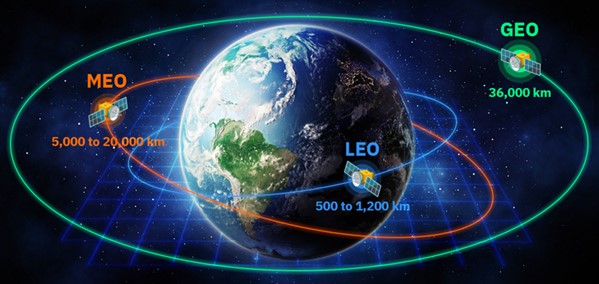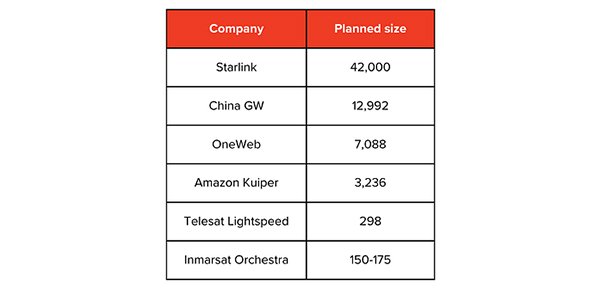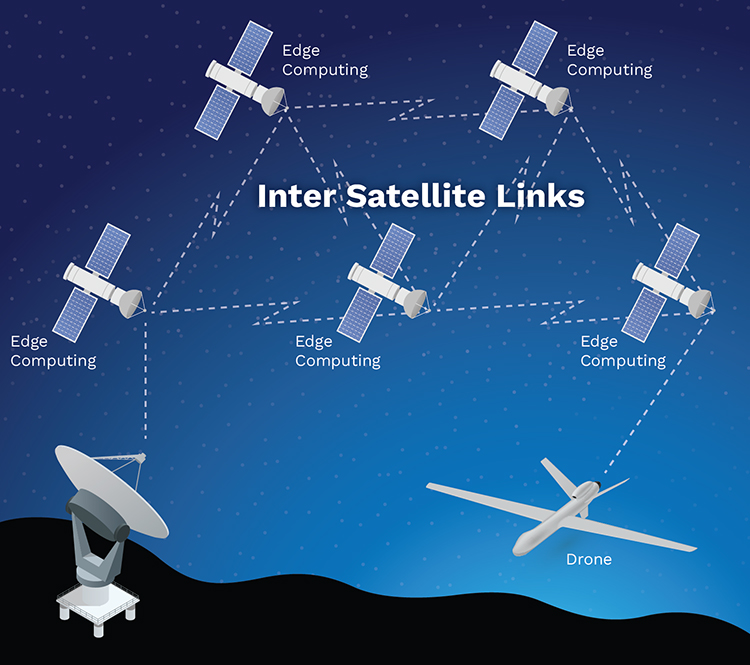
How AI Takes LEO Satellite Communication to the Edge
Why AI + Satellite Integration Matters
Satellite communication has always focused on ensuring fast, efficient long-distance connectivity, but in 2025, the market expects more than just coverage alone. People want to be connected at all times – with faster speeds, greater bandwidth, and minimal latency. Among the different satellite orbits, Low Earth Orbit (LEO) systems are poised to meet these demands, but the real breakthrough comes when AI enters the equation.
AI integration in satellites significantly reduces reliance on ground-based operations by enabling onboard decision-making. For mega constellations that involve hundreds or even thousands of satellites, real-time control from Earth is logistically impractical. With AI, however, satellites can operate more autonomously, analyze data on-orbit, and deliver actionable insights faster than ever before.
What are LEO Satellites?
LEO satellites orbit between 500 and 2000 km above Earth. Compared to Medium Earth Orbit (MEO) and Geostationary Earth Orbit (GEO) satellites, LEO systems deliver:
- Reduced Latency: LEO satellites provide faster communication due to lower altitudes.
- Stronger Signal Strength with Energy Efficiency: Close proximity to Earth means reduced power requirements for transmission. This reduces costs per unit, although more units are needed since they cover less territory.
- Enhanced Communication and Observation Capabilities: LEO satellites are optimal for Earth observation, remote sensing, and communication systems.

Many LEO satellites can be classified as smallsats. Their compact, lightweight, and cost-effective design supports rapid deployment and easy replacement, which makes them an ideal solution for large-scale satellite networks.
For reliable global coverage, LEO arrays are deployed in large numbers, sometimes thousands at once, creating “mega constellations.” These networks provide connectivity outside urban centers in areas where terrestrial coverage is limited or nonexistent. Whether you’re trekking deep in the wilderness, exploring off-grid, or travelling outside city limits, it’s likely an LEO satellite quietly delivering the GPS data that keeps you on course.
The Rapid Growth of LEO Constellations
In 2022, the U.S. Government Accountability Office (GAO) estimated that there are 5,500 active satellites orbiting Earth. With projections of an additional 58,000 launches by 2030, this skyrocketing growth (pun intended) presents both opportunities and challenges for how satellite networks are built, secured, and managed.

The rapid adoption of LEO is driven by a combination of technical advancements and new use cases that highlight their unique value:
- Network Resiliency: SpaceX’s Starlink has already deployed thousands of LEO satellites to deliver high-speed internet in the most remote areas across land, sea, and air. Beyond broadband, Starlink demonstrates how proliferated Low-Earth Orbit (pLEO) satellites add resiliency by building redundancy into networks. pLEO designs enable greater resistance to disruptions from natural causes or adversarial actions, such as anti-satellite (ASAT) weapons.
- Direct-to-Cell Services: This new use case allows smartphones to connect directly to LEO satellites when terrestrial equipment is unavailable (remote deserts, mountains, ocean vessels, etc.). Rather than replacing existing infrastructure, direct-to-cell capabilities are complimentary solutions that bridge connectivity gaps by expanding coverage in hard-to-reach locations.
- Smallsat Scalability: The rapid scalability of LEO smallsat constellations can also be attributed to increasing adoption rates. Ideal for intelligence, surveillance, or reconnaissance (ISE), smallsats can be quickly deployed to fill gaps, expand coverage, or replace lost assets. Their agility and scalability makes them essential to both government and mission-critical systems.
How Edge Processing Expands LEO SatComm Capabilities
AI integration in satellite communication isn’t ChatGPT, we’re talking about serious data processing, real-time decision-making, and eliminating data bottlenecks. In 2025 and beyond, AI can no longer be looked at as just a tool; it has become an essential force multiplier that allows us to process, analyze, and act on mission data at previously unimaginable speeds.
AI Moves from Tool to Strategic Advantage
By embedding AI directly into satellites, operators and organizations can focus on more important and higher-level strategic decisions that only a human mind is equipped to make. This accelerates the Observe, Orient, Decide, Act (OODA) loop, giving joint force leaders the ability to make split-second decisions with high confidence.
Optimizing Data Lifecycles
Modern Earth observation satellites generate a massive volume of optical, radar, and thermal data. One of the most transformative impacts of AI in LEO satellites lies in data lifecycle optimization. Instead of downlinking terabytes of raw data to Earth for processing, AI models can now enable on-orbit data processing for faster analysis.
By processing data at the source through edge computing, the real-time benefits include onboard classification, anomaly detection, and prioritization. A satellite monitoring deforestation, for example, can automatically flag and transmit high-risk zones instead of streaming unfiltered data. This type of edge processing also helps satellites conserve bandwidth and deliver actionable insights faster.

Edge Computing in Action
Edge computing is essentially AI on the satellite performing local calculations to minimize the amount of data that must be transmitted back and forth from ground control. Edge processing offers several mission-critical advantages:
- In defense applications, on-orbit processing supports battlefield intelligence gathering as it limits the time and bandwidth requirements.
- Dynamic signal routing provides optimized communication with reduced latency and bandwidth management.
- AI empowers satellites to operate autonomously and self-manage critical functions like power optimization, thermal regulation, orbit adjustments, and collision avoidance without constant reliance on ground stations.
Key Applications of AI-Enhanced LEO Satellites
Defense and Security
- Application: AI filters and analyzes signals for surveillance, jamming detection, and secure communications.
- Benefit: Rapid threat detection and response in congested environments.
Real-Time Communication Management
- Application: AI optimizes routing and inter-satellite links in mega constellations.
- Benefit: Improved network efficiency, reduced latency, and enhanced reliability for broadband and IoT connectivity.
Autonomous Operation
- Application: Satellites use AI for self-diagnostics and predictive maintenance.
- Benefit: Reduces reliance on ground control, lowers operating costs, and extends satellite lifespan.
Earth Observation and Remote Sensing
- Application: AI processes high-resolution images and sensor data in orbit.
- Benefit: Bandwidth savings and actionable insights for wildfire detection, crop monitoring, and disaster response.
Overcoming AI-Driven LEO Satellite Design Challenges with Solutions Available at RFMW
While the benefits are clear, AI integration in satellites also raises technical challenges. Adding edge processing reduces latency and bandwidth demands but requires greater onboard capabilities, which leads to larger payloads and higher power consumption. Since LEO platforms are already constrained by strict size, weight, and power (SWaP) limitations, efficiency is critical to keep launch costs low.
Backed by decades of success from industries spanning commercial telecommunications to aerospace, RFMW is a total solutions provider for innovation. Our comprehensive portfolio includes solutions designed for size and power constrained platforms. From efficient power amplifiers to cutting-edge timing devices, RFMW supports designers and engineers alike in meeting the challenges of AI-driven satellite communications head-on.
Power Amplifiers
Qorvo
With more than four decades of SATCOM expertise, Qorvo has established itself as a trusted supplier of RF solutions for both commercial and defense satellite applications. Their portfolio supports secure and efficient uplinks, adaptive RF architectures, and advanced beamforming technologies, all designed to meet the rigorous demands of user terminals and gateways. Qorvo’s focus on low noise, compact integration, and streamlined calibration makes them a strong partner for engineers designing next-generation LEO and other satellite systems.
An example is the QPA1724D, a high-power Ku-Band MMIC amplifier optimized for SATCOM and radar. Built on Qorvo’s proven 0.15 μm GaN-on-SiC process (QGaN15), it operates across 17.3 to 21.2 GHz and delivers 5W of linear power with –22 dBc IMD3, or up to 20W saturated output. The device offers 25 dB of small-signal gain, 30% power-added efficiency, and includes an integrated power detector for diagnostics. Fully matched to 50Ω with DC-grounded I/O and on-chip blocking capacitors, the QPA1724D simplifies system integration while ensuring robust ESD performance, making it a strong candidate for demanding LEO satellite designs
Attenuators
Smiths Interconnect
TSX Series Chip Attenuators from Smiths Interconnect are optimized for demanding space applications where performance, size, and reliability are critical. Designed using a robust all-thin-film process on alumina, these chip attenuators deliver exceptional RF performance from DC to 50 GHz while maintaining a compact footprint in 0604 or 0404 packages. With power handling up to 3 watts and low VSWR across a broad frequency range, the TSX Series supports efficient power transmission and thermal stability in high-reliability environments. Engineers can choose from a wide range of attenuation values with tight tolerances, ensuring precise signal control across satellite communications, radar systems, and high-frequency T/R modules.
Available in both solder-mount and chip-and-wire formats, TSX attenuators integrate easily into hybrid space-qualified designs. Their miniature size and lightweight construction help reduce overall SWaP—an essential advantage for modern spacecraft and satellite payloads. Backed by Smiths Interconnect’s space heritage and proven performance, the TSX Series offers a rugged, high-frequency attenuation solution well-suited for the extreme thermal, mechanical, and radiation conditions encountered in space.
Filters
Knowles
Knowles has 40+ years of space heritage and has an exceptional line of high-reliability MLCCs and RF/Microwave filters for the aerospace and defense markets. The Knowles B192NB2S Is a standard catalogue RF Filter that covers the full HTS downlink band plus HDFSS bands, enabling coverage in all ITU regions. It is specified to meet 5W CW and wide band rejection from DC to 35 GHz, with alternate narrow band options available to support individual 1 GHz BW ITU channels upon request.
Microchip
Microchip has a long heritage of providing space grade SAW devices for use in IF and GNSS applications. The TDX1210 L1 L2 diplexer offers high reliability and small form factor with excellent channel isolation for accurate positioning applications. With new developments in Direct to Phone applications, Microchip SAW technology is well suited to support standard LTE bands with high reliability packaging technology for a more robust solution suited to the harsh environment it will operate in.
Combiners
Nuvotronics
Nuvotronics Polystrata® technology offers high performance subminiature combining ideal for use in SSPA designs for Space applications. The PSX29Q03W is a low loss combiner at 27.5 to 31GHz with Wirebond inputs and a waveguide or coax output, perfect for combining high power Die. Able to withstand up to 100W CW the device enables a new era of small form factor SSPA’s to enter the market.
Low Noise Amplifiers (LNA) & Gain Blocks
Qorvo
Qorvo’s low noise amplifiers deliver industry-leading noise performance and are built on their advanced pHEMT technologies. Available with 0.15 µm, 0.25 µm, and 0.5 µm gate lengths, these LNAs offer optimized solutions for a wide range of high-performance applications.
Qorvo’s QPA2735 and QPA2628 are high-performance, packaged low noise amplifiers optimized for satellite and point-to-point communication systems. Both are built on Qorvo’s 90nm pHEMT (QPHT09) process and come in compact 4 x 4 mm QFN packages with 50-ohm matching and integrated DC blocks for easy integration.
The QPA2735 operates from 13 to 20 GHz, offering 26 dB gain, 18 dBm P1dB, an ultra-low 1.1 dB noise figure, and excellent linearity with IM3 of −58 dBc at 0 dBm/tone. In contrast, the QPA2628 covers the higher 22 to 31.5 GHz band, delivering 23 dB gain, 19 dBm P1dB, and a 1.6 dB noise figure with IM3 of −54 dBc. This makes it a strong candidate for Ka-band satellite systems requiring robust gain and linearity at higher frequencies. Both LNAs are lead-free, RoHS compliant, and supported with evaluation boards for streamlined design-in.
Guerrilla RF
The Guerrilla RF GRF2013 and GRF3042 are compact, low-power gain blocks ideal for applications like small cells, microwave backhaul, and instrumentation. Both offer broadband performance with low noise figures and flexible tuning options.
The GRF2013 covers 700 MHz to 3.8 GHz (extendable to 9 GHz) with a selectable IDDQ (15–100 mA) and supply range of 2.7–8 V, enabling excellent efficiency and linearity. The GRF3042 spans an ultra-wide 10 MHz to 15 GHz range, with internal 50 Ω matching and a typical 3.5 dB NF, making it ideal for general-purpose and microwave band amplification.
Narda-MITEQ
Narda-MITEQ’s SLNA low-noise amplifiers are COTS solutions built for space applications from LEO to deep space. Covering 100 MHz to 40 GHz with gain options of 30, 40, or 50 dB, these LNAs are available with screening levels from NASA Level 3 to MIL-PRF-38534 Class K. Hermetically sealed in Kovar housings and rated for up to 200 krad radiation tolerance, SLNAs combine space-proven materials and processes with reduced mission risk, cost, and lead times.
Read more about their entire product line-up here: New Product: Space Low Noise Amplifiers (SLNA) – Narda-MITEQ
Power Dividers
Marki
The MPD4-0422CSP2 is a miniaturized power divider from Marki Microwave that directly addresses new space applications. These Wilkinson power dividers in Marki’s patented chip scale package (CSP) technology significantly reduce component size by up to 75% while maintaining broadband, high frequency performance and streamlining integration. Marki Microwave partners with LEO satellite customers to tailor testing and qualification processes to specific mission needs.
Beamforming
Qorvo
Qorvo’s second-generation SATCOM beamformer IC family is engineered for high-performance flat panel antennas supporting LEO, MEO and GEO satellite constellations. Designed for SATCOM-on-the-move applications, these highly integrated quad-core silicon ICs simplify active antenna designs with full polarization flexibility, gain compensation over temperature, and on-chip temperature reporting. All four devices operate from a single +1.2V supply, include ESD protection on all pins, and are offered in wafer-level chip scale packages (WLCSPs) ideal for low-profile, planar phased array antennas.
The AWMF-0146 and AWMF-0147 form Qorvo’s Ku-band beamforming pair, with the 0146 optimized for receive (Rx) paths and the 0147 for transmit (Tx). For higher frequency operation, the AWMF-0197 (Rx) and AWMF-0198 (Tx) provide Ka-band coverage, making them well-suited for applications requiring wider bandwidth and higher data rates. With identical core architectures and feature sets across bands, system designers can seamlessly scale and configure beamforming capabilities to match evolving terminal requirements across the satellite spectrum.
Axiro
Axiro’s F6413 and F6415 TRx Beamformer family delivers proven performance for next-generation X- and Ku-band phased array systems. With a strong heritage in SATCOM and defense markets, Axiro brings deep expertise in designing high-frequency, high-complexity ICs that meet the demanding reliability requirements of space applications. Their scalable chip solutions are already enabling beamforming architectures in both commercial and military satellite systems, where size, performance, and integration are mission-critical.
The F6413 (8–12 GHz) and F6415 (12–18 GHz) each feature 8 transmit/receive channels, a compact layout ideal for λ/2 antenna integration, and a high linear output of +20 dBm P1dB. Designed for electronically steered arrays, these parts support ultra-fast beam steering and are housed in an exposed die BGA package for efficient thermal management. With robust performance in Frequency-Modulated Continuous Wave (FMCW) and pulsed radar, SATCOM, and point-to-point terminals, this beamformer family is well-suited for high-density, space-qualified Electronically Steered Arrays/Phased Array Antennas.
Learn more on the Axiro website.
Oscillator/Timing devices
To function correctly, at the heart of any satellite is a timing device providing fundamental system accuracy to all other satellite operations. Ensuring performance timing solution is a worthwhile investment given the risk to the operational integrity of the equipment.
SiTime
While not specifically designed with space applications in mind, the fundamental properties of MEMS timing (Low G Senitivity and High Shock Immunity) has meant that SiTime products have been used on multiple launch vehicles with great success for on board microprocessor applications. Read more about the SiTime SiT514x family of ruggedised TCXO’s for GNSS as an example.
Rakon
The Rakon RK508NS is a NewSpace OCXO with excellent phase noise performance and low power consumption. It features Rakon’s proven and highly successful proprietary Mercury+™ Integrated Circuit (IC) technology. Providing a Total Ionizing Dose (TID) resistance of up to 30 krad, the MercuryR™ (Rad-Hard) ASIC was specifically developed to withstand the harsh radiation environment encountered in Traditional Space and NewSpace applications. The RK508NS is designed for mission length up to 12 years.
Circulators and Isolators
Sonoma Scientific
Sonoma Scientific brings deep expertise in custom-designed RF and microwave ferrite circulators and isolators, with a portfolio of over 2,000 models. Their engineering capabilities enable tailored solutions for demanding satellite applications, including operation in harsh space environments.
With frequency coverage up to 50 GHz and power handling from milliwatts to kilowatts, Sonoma’s components are ideal for both low-power payloads and high-power transmission systems. Their compact, rugged packaging is especially suited to the size, weight, and durability constraints of LEO satellite platforms.
Trusted by military, aerospace, and satellite organizations worldwide, Sonoma Scientific meets stringent quality standards including MIL-I-45208, ensuring reliability in mission-critical systems.
Resistors and Terminations
Smiths Interconnect
Smiths Interconnect’s SpaceNXT HC-CXH Series Outrigger Resistors and Terminations are specifically designed for mission-critical space applications, including LEO satellite systems. Using a patented outrigger layout (US 8,994,490), these components deliver improved power handling—up to 50% more than conventional SMT solutions—by adding solderable side pads that enhance thermal dissipation. Operating from DC to 27 GHz with stable broadband performance, they support compact, lightweight system designs without compromising RF integrity.
Each unit is screened to MIL-PRF-55342 with 100% Group A testing and optional Group B and C qualification, ensuring long-term reliability and mission assurance. The series comes from a standardized part list, simplifying procurement while providing full test data for flight compliance. Manufactured with a mix of thick and thin film technologies, these lead-free, RoHS-compliant components are well-suited for amplifier chains, converters, and T/R modules in high-reliability LEO payloads.

